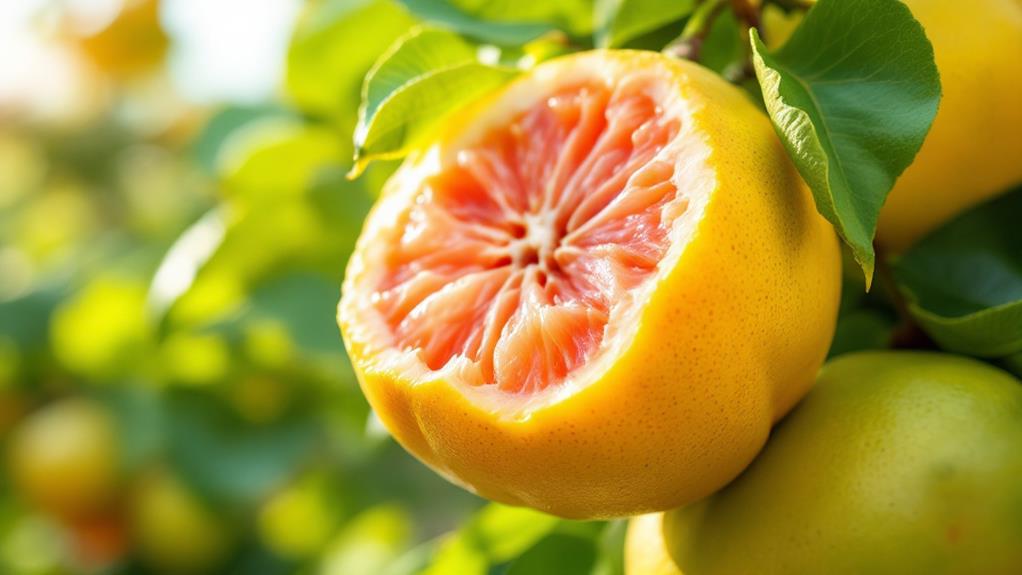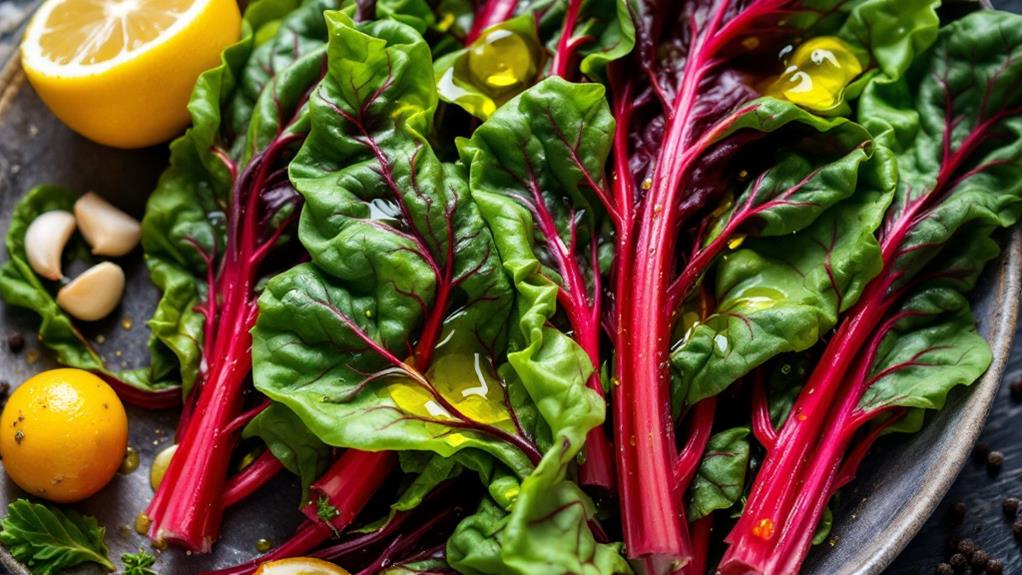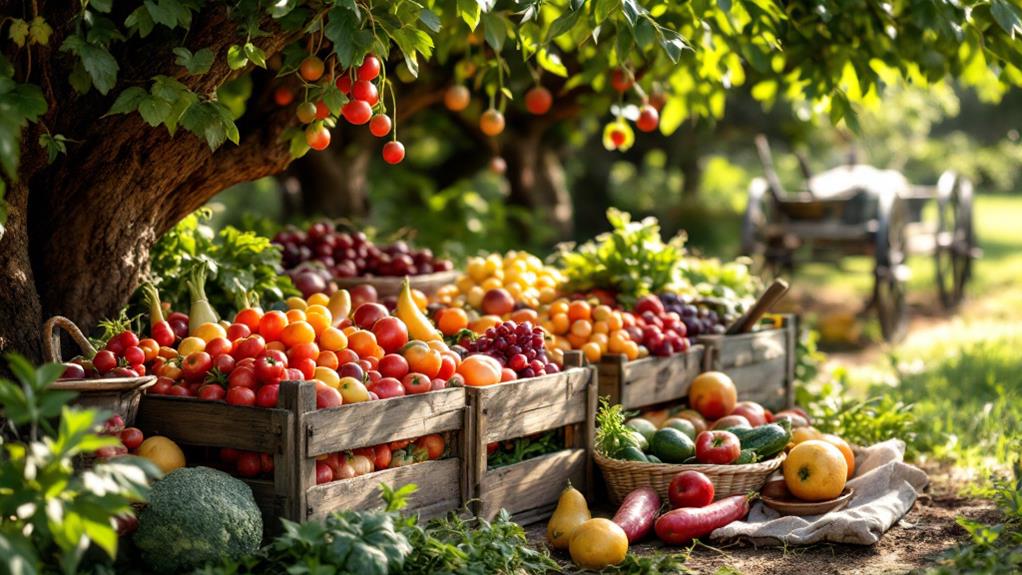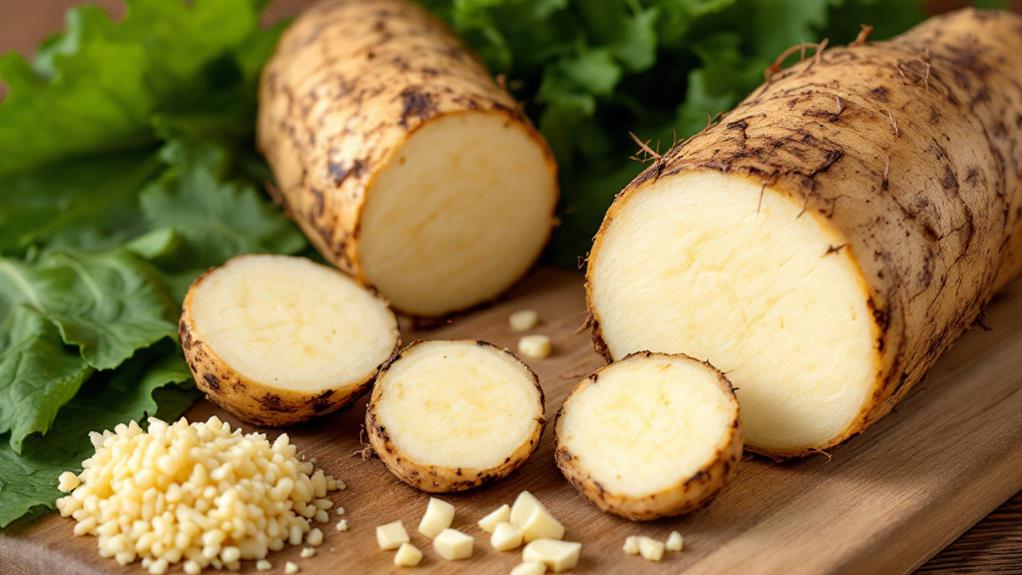Summertime Fruit: Get to Know Your Drupes and Stone Fruits
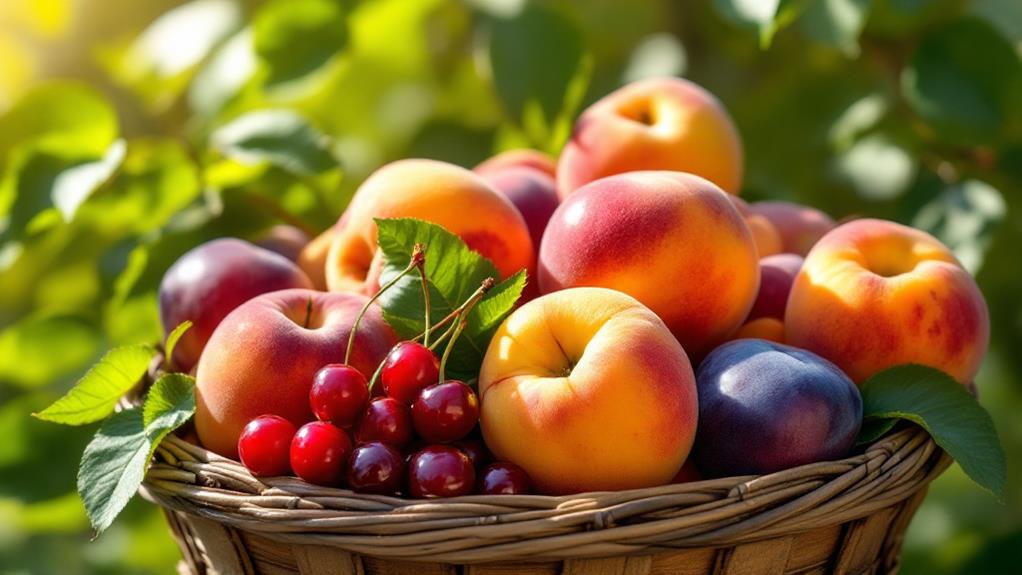
Get to know the lively world of stone fruits, also known as drupes, which include peaches, plums, and cherries. They boast a juicy flesh surrounding a hard pit, perfect for summertime enjoyment. Peaches come in clingstone and freestone types, each suited for different dishes. Tropical varieties like mangoes delight your palate, while hybrids such as pluots offer unique tastes. Stone fruits are rich in vitamins and antioxidants, supporting health while keeping calories low. Regardless of whether you're grilling them or slicing for salads, their sweet and savory potential is endless. There's so much more about these delicious options waiting for you.
Understanding Stone Fruits
Regarding understanding stone fruits, there's a lot to appreciate about these summer favorites. Stone fruits, also known as drupes, are cherished for their juicy, fleshy outer layer and central pit. They bring a delightful sweetness to your summer meals, especially when freshly picked. Among these, peaches stand out as a beloved choice. When choosing peaches, you'll encounter two main categories: clingstone and freestone. Freestone peaches are particularly convenient because the pit easily separates from the flesh, making them perfect for fresh eating or baking.
Stone fruits are not just delicious; they're packed with nutrition. They're rich in vital vitamins A and C, which are significant for maintaining healthy skin and immune function. Furthermore, their high dietary fiber content supports digestive health. When selecting these fruits, focus on indicators of ripeness, such as a sweet aroma and slight softness when gently squeezed. Wrinkles near the stem often suggest peak sweetness, ensuring you get the freshest flavor.
Types of Stone Fruits
Now that you appreciate the nutritional benefits and characteristics of stone fruits, let's explore the different types available. Stone fruits include peaches and nectarines, which are known as drupes. They're classified into two types: clingstone and freestone. Clingstone peaches have pits that adhere to the flesh, making them ideal for canning due to their smaller size and sweeter taste. On the other hand, freestone peaches have pits that easily separate from the flesh, making them perfect for fresh eating. They are larger, juicier, and typically appear later in the season.
But the variety doesn't stop with peaches and nectarines. Stone fruits also encompass plums, apricots, and cherries, each offering its unique flavor and texture. Plums bring a tart sweetness, while apricots have a soft, velvety feel. Cherries, with their balance of sweet and sour, are summer favorites.
Don't forget tropical stone fruits like mangoes and coconuts, known for their distinct tastes and culinary versatility. Moreover, hybrids like pluots and apriums showcase creative possibilities within the stone fruit family, combining the best traits of plums and apricots. These diverse types of stone fruits offer something for every palate.
Preparing Your Stone Fruits
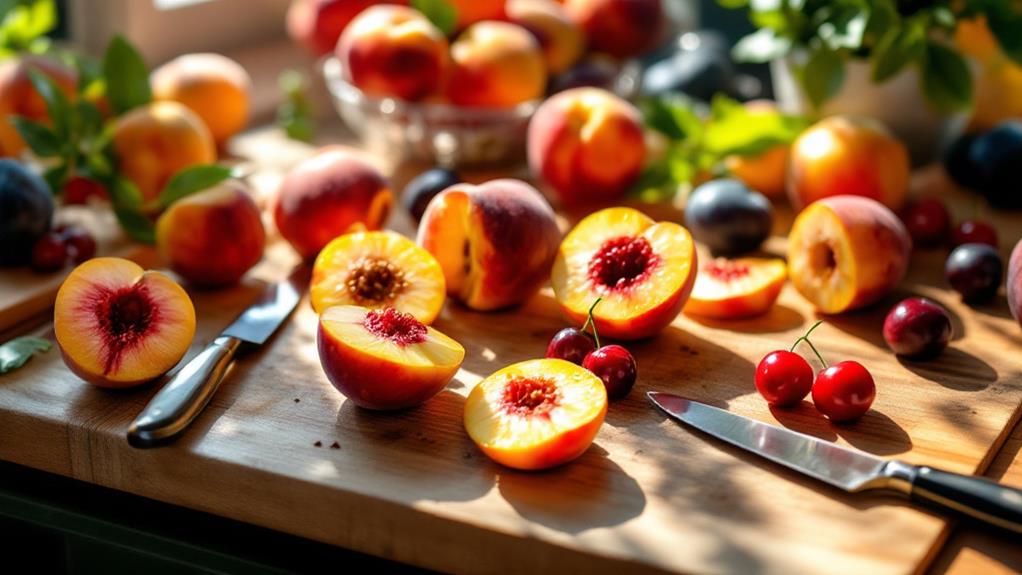
Plunge into the delicious world of preparing stone fruits by learning a few simple techniques. Start by washing your stone fruits thoroughly to remove any dirt or pesticide residues. Remember, it's best to wash them only right before you're ready to prepare and eat them; washing beforehand can lead to spoilage. Once cleaned, grab a small paring knife and pierce the fruit near the stem. This helps you locate the pit, which is crucial before slicing your fruit in half.
For larger fruits like peaches, after slicing, gently twist the halves apart to avoid bruising the delicate flesh. With clingstone varieties, such as certain peaches, the pit clings stubbornly to the flesh. In this case, slice the half containing the pit into wedges. This technique allows you to gradually work around the pit, removing the fruit without wasting any juicy goodness.
Whether you're working with plums or any other stone fruits, these methods will guarantee you prepare them effectively. By mastering these steps, you'll reveal the full potential of these summer delights, ready to be used in a range of recipes or simply enjoyed fresh.
Eating and Enjoying
With your stone fruits perfectly prepared, it's time to savor the delightful flavors they offer. You'll find these juicy gems can be enjoyed fresh or transformed into mouthwatering dishes that highlight their natural sweetness. Here's how you can make the most of your stone fruits:
- Enjoy Fresh: Simply wash and slice peaches, plums, or cherries to enjoy them fresh. They make for a quick, healthy snack, bursting with flavor and nutrients.
- Grilled Goodness: Try grilling stone fruits like peaches and nectarines. The heat caramelizes the sugars, creating a unique sweetness that pairs well with both savory dishes like grilled chicken or as a Summer Dessert when topped with ice cream.
- Peach Cobbler: Use those ripe peaches in a classic peach cobbler. It's a perfect Summer Dessert that's sure to impress at any gathering with its sweet, comforting taste.
- Versatile Recipes: Incorporate stone fruits into salads, salsas, or glazes. Their versatility shines, adding depth and flavor to a wide array of dishes.
These options allow you to enjoy the delicious taste of stone fruits while reaping their many health benefits.
Health Benefits
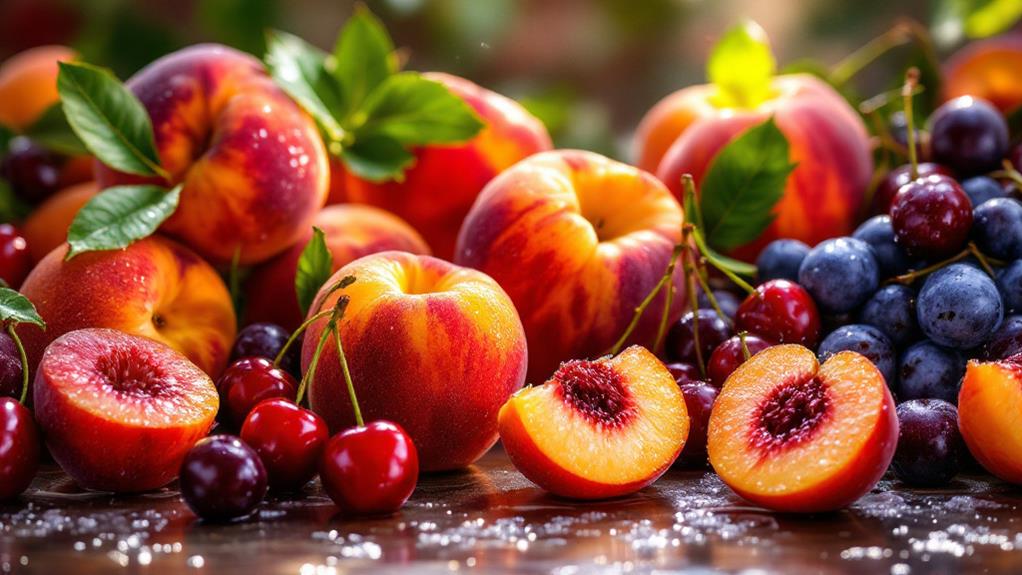
As you enjoy the luscious taste of stone fruits this summer, you'll also be reaping a host of health benefits. These lively fruits are packed with vitamins A and C, vital for enhancing your immune system and maintaining radiant skin. By including stone fruits in your diet, you're supporting your body's defense mechanisms and promoting a healthy, glowing complexion.
Stone fruits are also a fantastic source of dietary fiber, which is fundamental for good digestion. They can help regulate cholesterol levels, keeping your heart healthy. Plus, their low calorie content makes them an ideal snack for those mindful of weight management. You can satisfy your sweet tooth without derailing your diet goals.
Moreover, stone fruits are rich in antioxidants, which play a significant role in fighting oxidative stress. By reducing oxidative stress, you lower your risk of chronic diseases, including heart disease and cancer. Finally, the high water content in these fruits enhances hydration, perfect for staying refreshed during hot summer days. So, as you bite into a juicy peach or plum, know you're not just enjoying a delicious treat, but also nourishing your body in multiple ways.
Cooking With Drupes
If you're looking to improve your summer dishes, cooking with drupes offers a delightful way to do just that. These versatile stone fruits, including favorites like peaches, plums, cherries, and apricots, can uplift your culinary creations with their sweet and tangy flavors. When selecting drupes, focus on ripe fruit, as their aroma and slight softness indicate peak flavor. The right choice can transform both sweet and savory dishes into unforgettable meals.
When cooking with stone fruits, consider these tips:
- Freestone vs. Clingstone: Freestone fruits are easier to pit and slice, making them perfect for quick cooking. Clingstone fruits, with their sweeter and smaller flesh, are ideal for preserves and canning.
- Grilling and Roasting: Intensify the natural sweetness of stone fruits by grilling or roasting them. This method works wonderfully in desserts like cobblers, tarts, and crisps.
- Salads and Salsas: Add a revitalizing twist by incorporating stone fruits into salads or salsas. Peaches pair beautifully with herbs and proteins, offering a balanced dish.
- Herbs and Proteins: Combine nectarines or peaches with herbs like basil or mint for a delightful contrast, complementing proteins such as chicken or fish.
Experiment with drupes to create mouthwatering summer dishes!
Seasonal Availability
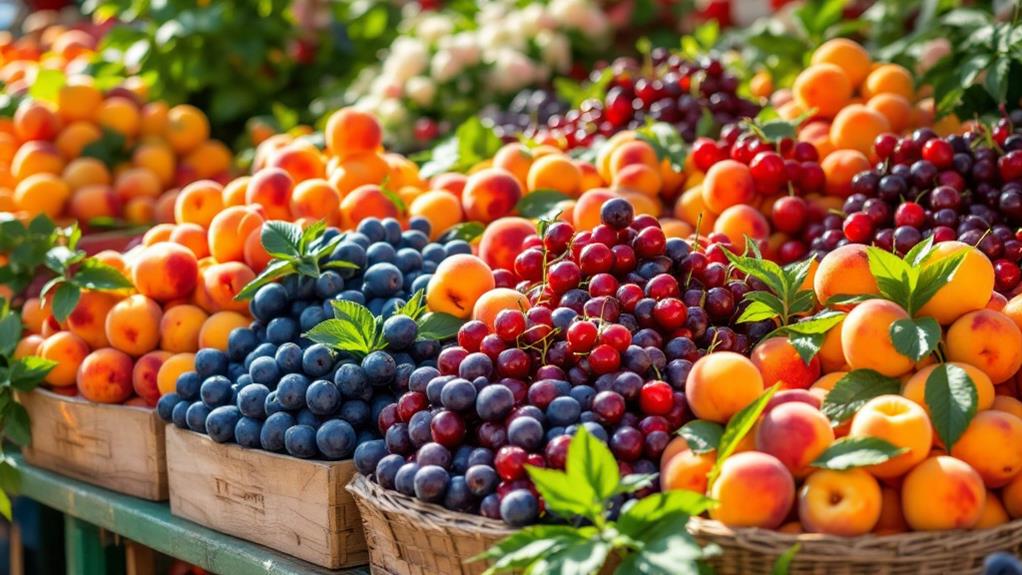
Stone fruits bring their juicy allure to the table during the summer months when they're at their best. These delectable treats, which include peaches, plums, cherries, and apricots, are typically in peak season from late spring through early fall. Cherries, for instance, mark the beginning of stone fruit season, with their perfect ripeness hitting in July and August. Following closely, peaches and nectarines reach their peak from mid-summer to early fall, offering a sweet and succulent experience.
Plums, on the other hand, have a more extended presence. Depending on the variety and region, they can be found from spring to early fall. Apricots, with their delicate flavor, are generally harvested from late spring, peaking in June and July. These fruits get their name from the hard "stone" or pit inside, which houses the seed.
While tropical stone fruits like mangoes and coconuts can be found year-round, their prime times vary based on climate and location. When selecting stone fruits, remember they require a little care in choosing the ripest ones. Enjoyed fresh, they offer a burst of summer's finest flavors, perfect for any seasonal delight.
Storage Tips
With regard to keeping your stone fruits fresh and flavorful, proper storage is key. Start by storing them at room temperature until they reach peak ripeness. This allows them to ripen naturally without refrigeration, which can slow down the process. Once your stone fruits are ripe, you can refrigerate them to extend their freshness. However, avoid washing them until right before you're ready to eat, as moisture can lead to spoilage.
Here are some crucial storage tips:
- Prevent Bruising: Use breathable containers like baskets or paper bags, not airtight plastic, to avoid bruising your delicate stone fruits.
- Check Regularly: Examine your stored fruits frequently for overripening or mold, as they can quickly deteriorate once ripe.
- Freezing for Long-Term Storage: For extended storage, wash, slice, and freeze stone fruits in a single layer. Once frozen, transfer them to airtight containers or bags.
- Room Temperature: Keep unripe stone fruits at room temperature, allowing them to develop full flavor before cooling.

